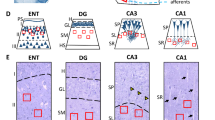Abstract
N-Methyl-D-aspartate (NMDA) antagonists cause neuronal vacuolation in the posterior cingulate and retrosplenial cortex of the rat. Because the nature of neuronal pathologic changes due to NMDA antagonists may affect the potential clinical use of this class of drugs, we undertook experiments to define the nature and time course of the vacuolation caused by high-dose (5 mg/kg) MK-801 (dizocilpine, 5-methyl-10, 11-dihydro-5H-dibenzo [a,d]cyclohepten-5,10-imine). Ultrastructural examination revealed the vacuoles to be not a form of hydropic cellular degeneration, but rather a dilatation of several intracellular compartments, chiefly endoplasmic reticulum and mitochondria. Study of the time course of the alterations revealed no light or ultrastructural features of neuronal necrosis in over 1 thousand neurons examined in layers 3 and 4 of the cingulate and retrosplenial cortex, 153 of which were vacuolated. The vacuoles resolved over time by decreasing in magnitude. Oxalate-pyroantimonate methodology revealed no redistribution of cell calcium in either vacuolated or non-vacuolated neurons. At 6 h, when vacuoles were consistently prominent in glutaraldehyde-fixed plastic-embedded tissue, a separate series of experiments was undertaken to vary methods of tissue preparation, and determine conditions under which vacuolation occurs. Frozen sections revealed no vacuoles. Subsequent paraffin embedding of the previously frozen tissue revealed no vacuoles, but vacuoles were seen in paraffin after perfusion fixation. Immersion fixation with brain refrigeration for 12 h prior to fixation revealed no vacuoles. Alcohol fixation also led to no visible vacuoles. We conclude that the vacuolation induced by NMDA antagonists is a reaction to aldehyde fixation of perturbed but living neurons, resulting in artifactual distortion of multiple intracellular compartments.
Similar content being viewed by others
References
Allen HL, Iversen LL (1990) Phencyclidine, dizocilpine, and cerebrocortical neurons. Science 247:221
Auer RN, Ingvar M, Nevander G, Olsson Y, Siesjö BK (1986) Early lesion and preserved microvasculature in, epilepsy-induced hypermetabolic necrosis of the substantia nigra. Acta Neuropathol (Berl) 71: 207–215
Borgers M, Thoné F, van Nueten JM (1981) The subcellular distribution of calcium and the effects of calcium-antagonists as evaluated with a combined oxalate-pyroantimonate technique. Acta Histochem [Suppl] (Jena) 24: 327–332
Buchan AM, Slivka A, Xue D (1992) The effect of the NMDA receptor antagonist MK-801 on cerebral blood flow and infarct volume in experimental focal stroke. Brain Res 574: 171–177
Clow DW, Lee SJ, Hammer RP Jr (1991) Competitive (AP7) and non-competitive (MK-801) NMDA receptor antagonists differentially alter glucose utilization in rat cortex. Synapse 7: 260–268
Dirnagl U, Tanabe J, Pusinelli W (1990) Pre-and psot-treatment with MK-801 but not pretreatment alone reduces neocortical damage after focal cerebral ischemia in the rat. Brain Res 527: 62–68
Duval D, Roome N, Gauffeny C, Nowicki JP, Scatton B (1992) SL 82.0715, an NMDA antagonist acting at the polyamine site, does not induce neurotoxic effects on rat cortical neurons. Neurosci Lett 137: 193–197
Hargreaves RJ, Rigby M, Smith D, Hill RG, Iversen LL (1993) LXVI-5. The effects of the competitive NMDA receptor antagonist CGP37849 on cerebral glucose metabolism and neuronal morphology. J Cereb Blood Flow Metab 13:S667
Hargreaves RJ, Rigby M, Smith D, Hill RG (1993) Lack of effect of L-687,414 [(+)-cis-4-methyl-HA-966], an NMDA receptor antagonist acting at the glycine site, on cerebral glucose metabolism and cortical neuronal morphology. Br J Pharmacol (in press)
Ingvar M, Folbergrová Siesjö BK (1987) Metabolic alterations underlying the development of hypermetabolic necrosis in the substantia nigra in status epilepticus. J Cereb Blood Flow Metab 7: 103–108
Kurumaji A, Nehls DG, Park CK, McCulloch J (1989) Effects of NMDA antagonists MK-801 and CPP, upon local cerebral glucose use. Brain Res 496: 268–284
Loubinoux I, Meric P, Correze JL, Borredon J, Tiffon B, Gillet B, Mispelter J, Beloeil JG Seylaz J (1993) LXVI-4. MK-801 activates cerebral metabolism and modifies that of excitatory amino acids. J Cereb Blood Flow Metab 13: S666
Mc Culloch J, Iversen LL (1991) Autoradiographic assessment of the effects of N-methyl-D-aspartate (NMDA) receptor antagonists in vivo. Neurochem Res 16: 951–963
Nevander G, Ingvar M, Auer RN, Siesjö BK (1985) Status epilepticus in well-oxygenated rats causes neuronal necrosis. Ann Neurol 18: 281–290
Olney JW, Ikonomidou C, Mosinger JL, Frierdich G (1989) MK-801 prevents hypobaric-ischemic neuronal degeneration in infant rat brain. J Neurosci 9: 1701–1704
Olney JW, Labruyere J, Wang G, Wozniak DF, Price MT, Sesma MA (1991) NMDA antagonist neurotoxity: mechanism and prevention. Science 254: 1515–1518
Ozyurt E, Graham DI, Woodruff GN McCulloch J (1988) Protective effect of the glutamate antagonist, MK-801 in focal cerebral ischemia in the cat. J Cereb Blood Flow Metab 8: 138–143
Park CK, Nehls DG, Graham DI, Teasdale GM, McCulloch J (1988) Focal cerebral ischaemia in the cat: treatment with the glutamate antagonist MK-801 after induction of ischaemia. J Cereb Blood Flow Metab 8: 757–762
Park CK, Nehls DG, Graham DI, McCulloch J (1988) The glutamate antagonist MK-801 reduces focal ischemic damage in the rat. Ann Neurol 24: 543–551
Roussel S, Pinard E, Seylaz J (1992) Effect of MK-801 on focal brain infarction in normotensive and hypertensive rats. Hypertension 19: 40–46
Simon R, Shiraishi K (1990) N-Methyl-d-aspartate antagonist reduces stroke size and reginal glucose metabolism. Ann Neurol 27: 606–611
Whishaw IQ, Auer RN (1989) Immediate and long-lasting effects of MK-801 on motor activity, spatial navigation in a swimming pool and EEG in the rat. Psychopharmacology 98: 500–507
Yao H, Ooboshi H, Ibayashi S, Uchimura H, Fujishima M (1993) Cerebral blood flow and ischemia-induced neurotransmitter release in the striatum of aged spontaneously hypertensive rats. Stroke, 24: 577–580
Author information
Authors and Affiliations
Additional information
Supported by a grant (MT-9935) from the Medical Research Council of Canada
Rights and permissions
About this article
Cite this article
Auer, R.N., Coulter, K.C. The nature and time course of neuronal vacuolation induced by the N-methyl-D-aspartate antagonist MK-801. Acta Neuropathol 87, 1–7 (1994). https://doi.org/10.1007/BF00386248
Received:
Accepted:
Issue Date:
DOI: https://doi.org/10.1007/BF00386248




